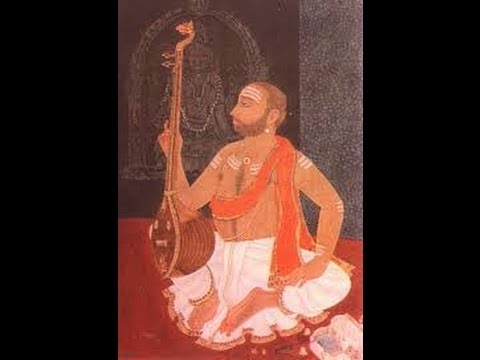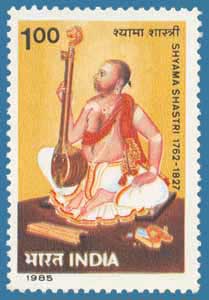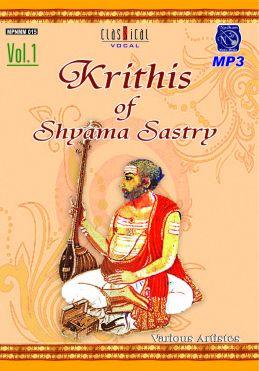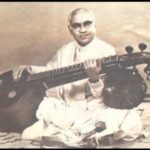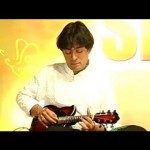Continuing our Series on great Andhra Personalities, is one who is often not recognised as an Andhraite, and yet, remains one of the highly honoured Trinity of Carnatic Music. Sri Syama Sastri is one such figure, who, like Veerapandya Kattabomman is shared by Telugus and Tamils alike.
As we’ll discover in this story, the beauty of the ancient Andhra desa is not only in its own inherent greatness, but in the Samskruthi it shares with the rest of South India, and indeed, the rest of Bharatavarsha itself. Here is one such Ratna of Bharata and an immortal in the realm of music.
Background
Syama Sastri was born in Thiruvarur on the second day of this month (April), in the year 1762 . His father was Visvanatha Iyer and grandfather was Venkatadri Iyer. They were of the Gautama gotra and attached to the Baudhayana Sutra. Despite no authentic biography existing, small accounts have been found here and there by Professor Sambamurthy in works such as the Gayaka Siddhanjanam, and others.
He hailed from the Vadamar community in Tamil Nadu, which traces its ancestry to Kambam in Kurnool District, Andhra Pradesh. Being Smartha Brahmanas, they are considered Andhras by heritage, the word Vadamar itself meaning “Northerner” [i.e. Telugu]. His vamsam specialised in scholarship and were in fact not originally archakas by profession, but later followed that occupation through the annointment of Adi Sankaracharya himself.
The story of the family’s migration South is one that is part legend and part adventure. During the noontide of the Rayas, they were in Kanchi. The sack of Vijayanagari caused them to flee Kanchi, and they wandered the forests for 28 years. They reached Gingee in 1594. After 15 years, they shifted to Udayarpalayam. The Zamindar (Paleyagar?) of the place invited them to settle, and they did so for 70 years. However, they eventually felt slighted, as only one family of archakas was receiving patronage. From there, they went to Kanchipuram (Conjeevaram) for 15 years. With the fall of the Vijayanagara Empire, however, Kanchi came under threat from the depradations of Golkonda and Bijapur sultanates. They then fled to Vijayapuram for another 5 years, before finally settling down in Thiruvarur. Here they resided for 45 years.
Thiruvarur was a famous and indeed blessed municipality in Tamil Nadu, as the other two jewels of the Carnatic Trinity also took birth there, and were, indeed, contemporaries. In fact, Syama Sastri was a good friend and frequent converser with Thyagaraja, and was even the guru of Muthuswami Dikshitar…such is the serendipitous, and indeed, transcendental connection amongst the Carnatic Trinity.
From the point of view of rasabhava Tyagaraja’s composition might be compared to the draksha (grapes), Muttuswamy Dikshitar’s to the nalikera (cocoanut), whose pulp can be eaten only after the shell is broken and Syama Sastri’s to the kadali (plantain fruit), to eat which we have only to peel off the thin skin. [1,25]
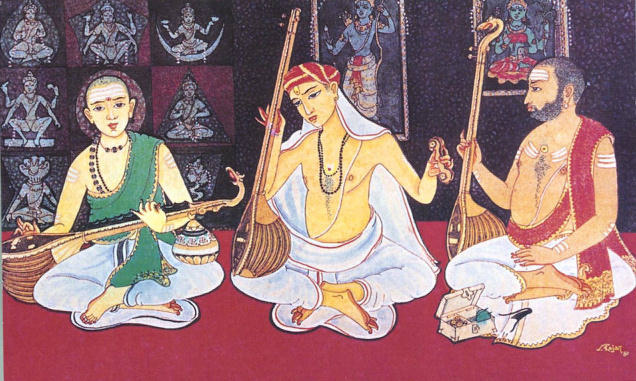
Nevertheless, the family would later migrate again, due the the politics, disorder, and depradations by foreign invaders of the time, and their descendants.
In the year 1781 when there was the fear of an impending invasion and devastation of the whole place by Hyder Ali and his men, our hero’s father Visvanatha …interviewed Raja Tulakaki (1765-1787), the then ruler of Tanjore and obtained his consent to come and stay with his family within the walls of the Tanjore fortress [1,10]
The Maratha Raja of Thanjavur (Tanjore) gave Syama Sastri’s father large estates, an agraharam and cultivable lands, along with a temple. This mandiram dedicated to Sri Kamakshi Amma is (as of 1934) served by an Archaka named Natesa Sastri, himself the great grandson of our Great Personality.
Syama Sastri was given a sound, traditional education in Sanskrit and Telugu, and learnt basic music from his uncle. Despite not coming from a family of musicians, Syama Sastri (called Syama Krishna by his loved ones, this later became his ankitam (signature))was a naturally gifted performer and composer of Sangeeta. At the age of 18, he (along with his family) shifted to Thanjavur. He had a sweet and melodious voice, but did not receive formal training until the myserious Sangeeta Swami initiated him. This was similar to the backstory of Thyagaraja Swami being presented with the work swararnava by Narada muni and Muthuswami Dikshitar being initiated by Chidambaranatha Yoga in Nija Sangeeta (true music). [1]
Sangeeta Swami was also an Andhra Brahmin, and he performed narthana (dance) for Sri Visveshwara in Varanasi. After coming to Tanjore, he noticed Syama Krishna’s talents, and informed his father of his wish to train him, predicting the son’s great destiny in music.
With his sound education in Sanskrit, Telugu, & traditional branches of knowledge, and complemented by his impressive intellect, Syama was an ideal student for Sangeeta.
His wife was known to be particularly virtuous, and devoted to her husband, rejoicing in his success and fame. Being a sumangali, she passed on before him. Such was Syama Sastri’s love for her that, rather than be sad, he smiled saying in Tamil : “Saga anjunal; setta arunal“. This meant he was happy that he only had to live 5 more days before joining her. This was particularly poignant, as Syama Sastri (like the other two members of the Trinity) was skilled at Jyotisha (astrology) and was said to be able to predict a person’s future merely by looking a his or her face. There were a number of anecdotes where his prophecies were literally proven to be true.
He passed away in the year 1827 C.E. His legacy passed on to his two sons Panju Sastri (a temple Archaka) and Subbaraya Sastri. The eldest son of Panju Sastri is (as of 1934) the archaka of the Tanjore Kamakshi Temple. Subbaraya Sastri is considered the inheritor of Syama Sastri’s musical legacy and trained not only under his father, but also under Thyagaraja. He later became a vaggeyakara (composer) of repute, with krithis such as “Nannu brochutaku” and “Sri Kamalambana” (in Todi and Desya Todi respectively).
Principle disciples of Syama Sastri, aside from his younger son, were Porambur Krishnayya, Alasur Krishnayya, Sangita Swami, and Dasari.
https://youtu.be/H4cEdcOkBZA
Achievements
Syama Sastri’s achievements are numerous. He was an highly accomplished scholar and musician of the highest order. The Sangeeta Trimurtis (Carnatic Trinity) made their stamp on an already ancient tradition, and provided the shape we know it in today.
They were born musicians and were kings in their own realm. They had the composer’s technique in them. Their kritis are raga crystals and for the polished nature of their music and the beauty of their language, their compositions will forever remain unsurpassed. [1, 1-2]
Syama Sastri’s contribution to this cannot be minimised. Despite being the least documented of the three, he had many accomplishments to his name, even though he took on only a few disciples who could spread his work:
- Wrote over 300 Compositions, primarily krithis and swarajathis, in his distinct style
- These musical works are scholarly in nature and have highly intricate time-measures
- Personally created valuable manuscripts detailing the various prastaras in the tala system
- Composed 9 Krithis (Navaratna-malika) in Praise of Goddess Meenakshi (Madurai)
- Exemplar of Nija Sangeeta (“True Music”)
- Humbled the hitherto undefeated musician Kesavayya of Bobbili in a contest
- Defeated the nattuvan (hereditary dance teacher) of Negapattam in a music contest
- Gave upadesam to Muthuswami Dikshitar
- Never deigned to engage in Nara-stuthi (praise of men), reserving his talents only to offer praise to God.
Like Thyagayya, Syama Krishna is said to have disdained royal patronage, and famously refused to go to Mysore to receive a Kanakabhisheka by the Maharaja. While Thyagaraja’s popularity is credited to his elegant but simple works that are accessible to the appreciation of the common person, Syama Sastri is considered an uncompromising exemplar, with scholarly krithis of great musical sophistication. Strong understanding of Classical Indic Music is required to gain and appreciation for his genius.
His compositions in apurva ragas like Manji, Kalagada and Chintamani stand as monu-mental proofs of his rare genius and originality in discovering ne forms in fields which to others were barren [1,22]
He is considered the midpoint between Thyagaraja’s simplicity and Muthuswami’s complexity. Famous compositions include 8 of the Navaratna-mallika:
“Devi Minanetri” (Sankarabharanam), “Nannu Brovu Lalita” (Lalita), “Marivere Gati” (Ananda Bhairavi), “Mayamma” (Ahiri), “Minalochana” (Dhanyasi), “Rave Parvatarajakumari” (Kalyani), “Devi Ni Pada Sarasa” (Khambo[j]i) and “Sarojadalanetri” (Sankarabharanam). [3]
Other notables are “Himachala Tanaya”, the Swarajathi “Kamakshi ni” and the famous krithi “Devi Brova Samayam idhe“. He is said to have defeated the conceited Kesavayya with this.
Legacy
The musical trinity of Carnatic Music has certainly indicated that music is not a profession, but is an offering to god.[2]
We are all aware that the songs of Shyama Sastri are noted for their intricate thala subtleties, while compositions of Thyagaraja are rich in bhava and the songs of Dikshitar highlight Raga Swaroopas. It is certainly remarkable that the basic features reflect the three vital aspects of music. [2]
If Thyagaraja was a great Rama Bhakta, Syama Sastri was a dedicated devotee of Durga. The various forms of Shakti were the inti devatas of the family, most notably, Goddess Kamakshi. This was reflected in his brilliant krithis. He is known to have had a special love for raga Anandabhairavi.
His famous defeats of Appukutti (Nattuvan of Negapattam) and Kesavayya are a testament to his talents. In the first case, the singer Syama defeated the dancer Appukutti in his understanding of music. In the second, he defended the court of Thanjavur from humiliation by a musician from Bobbili. In the case of Kesavayya, it was a defeat of manava music by the adhyatmika music and nija sangeeta of Syama Krishna.
He is said to have a had a fondness for chewing betel leaves. For this reason, he is frequently portrayed with them.
Ultimately, though not as well known, Syama Sastri’s contributions to Carnatic Music and Andhra Culture cannot be minimised. He brought a rare balance between simplicity and complexity, and a wonderful appreciation for both scholarship and devotion that is all too rare today. Despite his impressive intellect, he was not consumed with the quest of proving his knowledge, but rather, viewed one’s talents with the humility one should: as a gift from and offering to God. His music is proof of it.
Syama Sastri’s descendants are amongst us today, and indeed, much like our High Culture, are in a state of penury. Those great businessmen and captains of Industry who are the modern Vanijyas and Nayakas of today have a responsibility to give patronage to such cultured families, and restore them and our culture to former greatness.
References:
- Sambamurthy, P. (Professor of Musicology). Syama Sastri—And Other Famous Figures of South Indian Music. Sri Mahendhra Graphics: Chennai. 1999
- http://www.newindianexpress.com/cities/chennai/article574103.ece
- http://www.thehindu.com/todays-paper/tp-national/article1253106.ece
- http://www.thehindu.com/features/friday-review/history-and-culture/syama-sastry-did-travel/article5410501.ece
*A special acknowledgment should be made to the author of the above stated book. It is often difficult to assemble primary sources documenting the lives of our great personalities. The diligent and often selfless work of traditional pandits, modern historians, and self-driven biographers should be acknowledged. In this case, Professor P.Sambamurthy, Musicologist, deserves recognition for his work on Syama Sastri, bringing out many minute details for the benefit of posterity, making this Post possible. Dhanyavadam.
